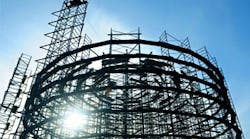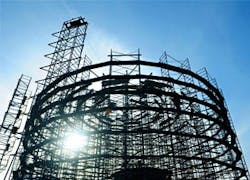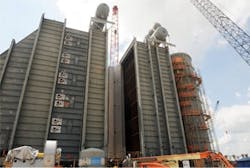Start collecting data on your assets at conception if you want to decrease lifecycle costs
In brief:
- There is growing focus on capturing relevant, quality data starting with the design of a capital project and improving upon it throughout the asset’s life and into retirement.
- Project managers and operations and maintenance (O&M) managers must begin sharing knowledge and data at the outset of the project, rather than waiting for the handover to operations.
- Collaboration fostered by better communication, systems and data allows for a smoother, more efficient transition through each phase of the asset lifecycle, and provides time savings, holistic visibility, and better data quality with which to manage costs and optimize ALM.
Asset lifecycle management (ALM) and costing is a process that must be continuously improved. The bulk of an asset’s costs are incurred during its operative life, but the data required to minimize these costs begins when the asset is first conceived. Because of this, there is growing focus on capturing relevant, quality data starting with the design of a capital project and improving upon it throughout the asset’s life and into retirement.
To accommodate this goal, project managers and operations and maintenance (O&M) managers must begin sharing knowledge and data at the outset of the project, rather than waiting for the handover to operations. In addition, information collected in the various systems used throughout an asset’s life needs to come together, whether through integration, reports, or an analytics dashboard.
Collaboration fostered by better communication, systems and data allows for a smoother, more efficient transition through each phase of the asset lifecycle, and provides time savings, holistic visibility, and better data quality with which to manage costs and optimize ALM.
Southern Company (www.southerncompany.com) and Sherwin-Williams (www.sherwin-williams.com) are already making strides in this area, and industry professionals working with organizations like Fiatech (www.fiatech.org) are actively promoting the concept to others.
Tackling the challenges
Figure 1. Asset management teams generally have limited input during facility development, design, and delivery. This is a lost opportunity to influence lifecycle cost. (Source: Fiatech)
The segmented responsibilities in the delivery and management of capital facilities, including the separation and accountability for budgets and schedules, is industrial ALM’s biggest challenge, according to Ray Topping, director at Fiatech, an international community of professionals working to make step-change improvement in the design, engineering, construction, and maintenance of large capital assets. “This leads to sub-optimizing in the steps in the delivery of facilities and a lost opportunity to optimize ALM,” Topping explains.
“Asset management teams generally have limited input during facility development, design, and delivery. This is a lost opportunity to influence lifecycle cost,” says Topping (Figure 1). “For instance, more than 80% of one capital facility’s costs occur during the facility operation. Nevertheless, information management throughout a project is mostly geared to the immediate needs of project delivery activities, not for the benefit of asset management.”
Atlanta-based Southern Company, through its subsidiaries, provides electricity to 4.4 million customers in the southeastern United States. The utility is approaching its journey to improve ALM and costing with a focus on the data (Figure 2). “We are collecting engineering information in the design organization as it relates to the asset and continuing that through the build/construct process and into handover. The intent is to carry that to retirement,” says Tedd Weitzman, engineering analyst at Southern Company.
Figure 2. Southern Company’s data quality initiative benefits asset lifecycle management. (Source: Southern Company)
“The short-term opportunity is to drive efficiency and quality through the project execution process. The long-term opportunity is leveraging asset data in the operations of the facility via reliability maintenance strategies, which reap huge cost benefit over the life of the facility,” says Weitzman.
Sherwin-Williams, producer of paints and coatings in the United States and throughout the world, has more than 26 plants in North America. Its IT organization developed and continues to refine operational dashboards that provide a common view of various data sources across the enterprise. From an ALM perspective, the dashboards provide insight into all assets and their performance.
“Dashboards allow engineering, O&M, quality, and data warehousing to all come together,” says Ted Krevis, manager of industrial applications at Sherwin-Williams. “Our dashboard application has embedded reporting capabilities that give the factory the ability to do data rollups, analytics and diagnostics on the data in support of continuous improvement,” he adds.
Focus on communication
Figure 3. The owner has to be more involved and dedicate resources much earlier in the project execution process. (Source: Southern Company)
Asset stakeholders need to communicate their needs. “O&M managers should develop their requirements for asset management, information management and handover, and gain senior management endorsement. Then, include those requirements as contract delivery terms in projects from the development stage through design, procurement, and construction,” says Fiatech’s Topping. “Also, have the asset lifecycle managers provide O&M reviews for projects through their development and delivery, similar to constructability reviews.”
Southern Company’s Weitzman agrees that the owner has to be more involved and dedicate resources much earlier in the project execution process (Figure 3). “I’m beginning to see that happen. Owners are recognizing how to negotiate contracts and the verbiage in contracts to include a clear set of definitions on data ownership and how to receive it into the organization at handover. Engineering, procurement, and construction (EPC) designers and engineers are recognizing the need to understand downstream goals,” he adds.
Asset tagging is an example. A very simple tagging nomenclature is put on the process and instrument diagram (P&ID), but the tagging structure within the asset management software is much more complex, usually incorporating some sort of system of accounts, functional location, or other conventions, according to Weitzman. The complexity is even greater for global, integrated oil and gas organizations. To reconcile this, a clear set of expectations and clearly documented tagging procedures are needed.
“Management support is absolutely necessary because the concept of managing ALM information is a culture shock, especially from a design perspective,” adds Weitzman. “We’re collecting a tremendous amount of usable data in the process of creating physical drawings, but there may be some nervousness among the design team about releasing that information for downstream consumption,” he explains.
Listening to the customer is also important. “Our industrial applications group is a customer-driven organization, which makes dashboard decisions a collaborative process. Sometimes, they’ll have ideas or we will stumble on something that might be of value,” says Dan Prudhoe, senior programmer at Sherwin-Williams.
“Having lots of eyes on problems in the factory lends itself to opportunities for more holistic solutions that can be leveraged across multiple factories,” adds Krevis. “At Sherwin-Williams, everyone from an operator in a factory to the top management of the company can access the dashboard from a Web link, and have visibility into how our machines and lines are running,” he explains.
Focus on systems
Most capital projects tend to be managed by different software systems throughout the lifecycle, Fiatech’s Topping observes. Design teams often use a project scheduling tool that is milestone- or design-package-driven. Construction projects are often managed with earned value solutions using varying integrated cost and schedule systems. Facility operations are now mostly managed with EAM/CMMS software or lifecycle asset management systems.
The ideal dashboard will consolidate and interpret data from as many information sources as possible and guide the user on where to dig for more information. “The data is already in a database somewhere, so there is essentially no cost to have IT add or exchange data. Using an open IT architecture allows you to integrate the data easily and continuously at a low cost,” says Sherwin-Williams’ Prudhoe.
“Breaking down barriers between different disciplines is the big win, and passing information between systems is where you get big gains,” says Krevis. “Once you get the information out of the controller/PLC and into a database, it allows people with other talents and skills, such as your IT staff, to help you solve problems on a day-to-day basis,” he adds.
Focus on data
Data can make or break ALM success. “Before you can leverage the data, you have to ensure its quality; otherwise you’re fighting a losing battle,” says Southern Company’s Weitzman. “Build in a set of tools to allow the design organization to maintain quality data, and, by doing that, you will ensure overall design quality.
“When you have a quality design with quality asset data and leverage it in construction, startup commissioning, O&M, supply chain — any downstream process that handles the asset — you can find ways to drive efficiencies,” adds Weitzman. “However, if your document management is not under control, don’t even attempt data quality management. Establishing document management processes is infinitely easier than data, and yet it is not easy if the organization is not ready,” he cautions.
Improve knowledge sharing
|
Fiatech Director Ray Topping believes design teams will benefit from asset management team knowledge of:
|
Sherwin-Williams began its operations-dashboard initiative with just a few key data points: production counts, order numbers, and the time between orders. “You can create an asset utilization application just from those three data elements alone, because it shows throughput on assets and also gaps between orders, which generally result from changeovers but also maintenance services,” says Krevis. “With this data, we can monitor metrics such as uptime, run speeds and quality, which roll up to overall equipment effectiveness (OEE) — the common baseline for performance,” explains Prudhoe.
If a dashboard passes uptime information to the asset management system, you can use the information to perform preventive maintenance (PM) on a use-based rather than time-based schedule, according to Krevis. The data also lends itself to monitoring mean time between failure (MTBF) and mean time to repair (MTTR). “You can show on a graph the PMs made on a machine or when they occurred, and whether the machine is up more as a result. If an adverse effect is evident, I consider it a success story for IT because you need to know if something got worse so you can fix it,” says Krevis.
Once you provide visibility, people will find uses for your software that you didn’t realize were needed. “We consider these unintended wins,” says Krevis. “We found out one of our maintenance guys reviews the dashboard every morning for uptime, machine performance, and whether there were long or short periods of downtime. When he saw long downtimes, he expected to have a work order for that machine sitting in the maintenance shop. All we gave him was the same dashboard we had built for operations and we had no idea maintenance could even use it,” explains Krevis.
Centralizing information allows shared learning across sites and encourages informed decision-making. “If another site installed new equipment and their performance is so much better, and we can get even 80% of that benefit elsewhere, it might justify the cost of replacement at other sites,” says Prudhoe.
Upgraded data quality
Southern Company first approached new data quality management (DQM) processes in 2007. “Our first goal was a fleet-wide problem,” explains Weitzman. “We already had a very good document management system and process, but our O&M and engineering construction services personnel couldn’t type in an asset or tag number and produce a set of documents that related to the asset. Instead, they searched by keyword,” he adds.
“We determined that 15-50% of a person’s time annually, and sometimes more, was spent searching for documents. Reducing the search time as it relates to assets, for every 200 employees within the organization, would save between $1.5 million and $8 million. We fixed the problem, which eliminated the time spent searching for asset-specific documentation,” explains Weitzman.
Another success involved asset lists. “Our startup and commissioning team requires a complete asset list. The list is maintained by groups further upstream, but previously it was not handed downstream. Now, comprehensive lists are made available to startups, eliminating time spent creating lists and ensuring better quality information,” says Weitzman. “Our goal is to extend the benefits to O&M and procurement, where accurate asset information and bill-of-materials data is needed to operate, maintain, and order parts for the assets,” he adds.
Some challenges were encountered. The data management tool was originally configured, piloted, and then shelved in 2007 after it was discovered the culture was not ready. “Thankfully, one of our upper-management team’s greatest achievements was in recognizing that the tool itself was not the problem. We needed to put a magnifying glass on our processes, procedures, and standards, and fix them to support DQM in order to drive efficiency throughout the organization. We worked on that from 2009 to 2011 and then put it into production. To this day, we are refining the procedures and standards because that is necessary to ensure continuous improvement,” says Weitzman.
3 ALM takeaways
Several approaches can be taken to improve ALM and costing, and the corporate culture will influence their success. “Getting information out to the enterprise provides opportunities to spot areas needing improvement,” believes Sherwin-Williams’ Krevis. “The main gains are achieved when you get visibility to and perspectives from as many people as possible. Engineering, O&M, quality, data warehousing — they all see different things on the dashboard,” he explains.
“You need to have a vision and to communicate that vision, and, from my experience, that vision needs to be supported and distributed by executive level management,” says Southern Company’s Weitzman. “Management also needs to recognize that managing a reference data library is not a part-time job, and it never stops. It will evolve as you adopt new technologies and create or improve processes. Everything touches the DQM configuration,” he adds.
Fiatech’s Topping believes that the future for lifecycle asset management will include continuing improvements, productivity advancement and efficiencies, which will come from many industry advancements including:
- improved CMMS applications
- increasing attention to delivering capital facilities with active input by O&M
- advancement of integrated 3D and information design and construction capabilities
- advancement of lifecycle information management systems
- implementation of automated field devices for O&M
- smart tagging of equipment and components for field maintenance
- implementation of integrated 3D and information modeling for O&M training and services
- more simulation-based training, including implementation of avatars for O&M training.




